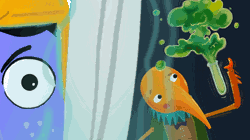- Interviews
- J. Allen Williams (Englisch)
Interviews
Über
Five years have passed since we last talked to Jeffrey Williams, the creator of the interactive movie DARKSTAR. The game was sometimes called the Duke Nukem Forever of adventure games, but Jeff succeeded in what 3D Realms didn't: He finished the product after one Decade of work.
In our interview, he tells in depth what postponed the development, how the product is received right now and what his next plans are going to be . Find out why the RUSH music is not in anymore, how DARKSTAR performed the step from one engine to another, how the game was shrinked from 44 gigabytes to "just" 14 and how one man was able to go through all of this for about ten years.
Here it is, our exclusive interview:
 Adventure-Treff: Jeff, thanks for taking your time for this interview. Unbelievable, but your baby is finally out in this world! How does it feel to give birth to DARKSTAR, that has been in production since nearly a Decade?
Adventure-Treff: Jeff, thanks for taking your time for this interview. Unbelievable, but your baby is finally out in this world! How does it feel to give birth to DARKSTAR, that has been in production since nearly a Decade?Jeffrey Allen Williams: It’s surreal in many ways, but there’s no resting on Laurels. We’re switching gears from production and testing to the global task of introducing DARKSTAR to the world, and we’ve begun on a very grass roots level.
A-T: DARKSTAR is distributed via several channels: At the moment you're distributing via home order at darkstarstore.com, via download platforms, and in 2011, a publisher will distribute it into store shelves. What was the reason to do it that way and can you share any experience you had so far since the release with its distribution?
Williams: Our strategy with this “Layered” release is working very well. Rather than doing this huge blitz all at once, we are building our following steadily one layer at a time. First we opened our own little online store and sold on Amazon, and in just a month have sold in nearly every state in the US and about 20 countries. Next, we released as a download through one of our partners Strategy First. Reviews are beginning to come in, and so far we are very pleased with the critical response. We had planned releasing in big box stores through Cosmi in the US, but we’re not sure that company is a good fit for us as they tend to deal with more “bargain” and “value” based products, and DARKSTAR simply does not fit into that niche very well. Now we are within a week or so of inking a deal with a very large European distributor who has approached us with what we believe will be a great way to help DARKSTAR find it’s global audience. I can tell you who that is next week, so stay tuned!

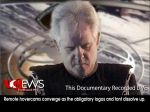

A-T: If you would have to describe DARKSTAR with just 3 words – what would they be?
Williams: Let’s see... “a psychedelic, back-stabbing, time-travelling, camp-comedy, horror, instant-cult-classic science fiction adventure.” Oh, that’s like fifteen isn’t it. Well, it’s better than “Soul Sucking Project.” I’ve been working on this a long, long time. Hell, you and I have been bantering about his for what, seven years? I need a vacation.
 A-T: You've also promoted DARKSTAR on your own via social networks, like Facebook. How important have the influence of user comments been to the final release of your game?
A-T: You've also promoted DARKSTAR on your own via social networks, like Facebook. How important have the influence of user comments been to the final release of your game?Williams: Critical. We have reached out to future fans via our website for years (since 2001), surveys placed strategically on gaming sites and other fan sites, and extensively through our Facebook fanbase. Wikipedia and IMDB pages sprouted on their own.
I was amazed at the amount of interest there was on a grass-roots level from people who’d been watching this thing develop through the years, and their enthusiasm when it came to giving us ideas. I personally listened to each one, and it is safe to say that the fans helped make critical decisions on what the content would be, how we would sell and market it, and what other ancillary aspects we should offer. I have gotten to know so many fans throughout the world in this journey, and remember hundreds of these peoples’ names.
A-T: What are the first reactions of the community since it has come out?
Williams: I never expected DARKSTAR to be a big critical hit for many reasons. It’s not a button mashing, sword flinging, gun blasting, blood-spattering gore-set-on-ten first person shooter, and Adventure Games are the enigma with a stigma — always getting the rap (undeservedly so) of being “old-school”. So we embraced the retro at the get-go, we raised our freak flag high and proudly as a few nerds and geeks putting out something that WE like.
 So when we got our first review saying it was the best game of 2010, I was completely sidewhacked. Our second one by J. Robinson Wheeler for BrassLantern was not as “glowing”, but the reviewer gave us a solid thumbs up and his bar of comparison lined our humble independent release parallel to AAA games of the genre — and he said we measured up, and proceeded to enthusiastically recommend the game to his readers. I really liked what he had to say, and I’m finding the critics like an underdog — and if we’re nothing else, we’re that.
So when we got our first review saying it was the best game of 2010, I was completely sidewhacked. Our second one by J. Robinson Wheeler for BrassLantern was not as “glowing”, but the reviewer gave us a solid thumbs up and his bar of comparison lined our humble independent release parallel to AAA games of the genre — and he said we measured up, and proceeded to enthusiastically recommend the game to his readers. I really liked what he had to say, and I’m finding the critics like an underdog — and if we’re nothing else, we’re that. As far as fan feedback, it’s been pretty overwhelming. Hundreds of emails telling us what their favorite parts were. „It was worth the wait.” That really makes me happy. I’ve got one guy who sent me a screaming “Darkstar sucks” email because he couldn’t get out of the first room. I sent him the clues he needed personally and he wrote back with a very kind apology, saying he thought the email was going to some corporate robo-machine.
A-T: DARKSTAR made some transitions from the beginning to what it is today. Let’s talk about some of them. First, you were able to bring down the hours of footage of DARKSTAR to "just" 13 GB. How have you accomplished that and is there any difference in terms of quality of graphics or sound compared to the first version with around 44 GB?
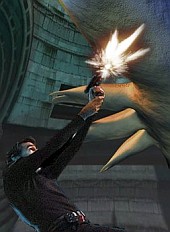 Williams: That round of compression was the game-changer for us. That seven dual-disk, 44-gig leviathan was not performing well and was going to be expensive to manufacture. The original iteration was designed to work in two modes, one as a full install, the other as a partial install requiring you to play of the disks. When I received the first round of tests on this version, it was clear it was simply not viable. The full install took nearly four hours to install, and had to be attended because you had to change disks seven times. The partial install just didn’t play smooth enough off the disks, and in some parts of the game was insanely clunky, and I’d gotten too acclimated to the smooth performance the game delivered with a full install. I had painstakingly pre-rendered all of my footage at 800x600 and the idea of doing any compression made me nauseous. I did not expect what happened next.
Williams: That round of compression was the game-changer for us. That seven dual-disk, 44-gig leviathan was not performing well and was going to be expensive to manufacture. The original iteration was designed to work in two modes, one as a full install, the other as a partial install requiring you to play of the disks. When I received the first round of tests on this version, it was clear it was simply not viable. The full install took nearly four hours to install, and had to be attended because you had to change disks seven times. The partial install just didn’t play smooth enough off the disks, and in some parts of the game was insanely clunky, and I’d gotten too acclimated to the smooth performance the game delivered with a full install. I had painstakingly pre-rendered all of my footage at 800x600 and the idea of doing any compression made me nauseous. I did not expect what happened next. My local tech guru Roger Jared is the king of compression, his most common daily task broadcasting high-resolution webinars worldwide for a large American firm. We had thousands and thousands of clips to compress, and over the years some had slightly different settings, some stereo, some 5:1 surround, some with different frame rates…it was a nightmare. And we had to come up with a custom compression setup that would work for all of these scenarios, no out-of-the-box solution was going to work. But we sorted through it all one file at a time for six weeks, all of the footage equaling over 13 hours linear — a world record for any game I am certain. And at the end of it all, it looked BETTER. I always preferred a very moody, contrasty look where the blacks were solid black and the colors punched through vibrantly. The compression process actually did this by boosting the gamma slightly, and with no artifacts or distortion. And we shed 31 Gigs, effectively saving the project. It was leaner, looked better, performed dramatically better, and by dropping five of the disks made it possible to hit a lower price point, something that was ALWAYS very important to me to do. I always wanted DARKSTAR to sell more copies at a lower price, and still give the customer a huge amount of content. Obviously, with a ten-year schedule, we did not skimp on R&D, we put it all out there 100% knowing we’d probably lose money over it. I accepted that day one because it was my money to lose, and I wanted DARKSTAR to be the very best I could produce.



A-T: You once mentioned a possible Blu-Ray release of DARKSTAR. Is this in consideration, possibly with higher resolutions or better quality or is the 13 GB now “the thing”?
Williams: Sony Blu-Ray is a wonderful delivery method and I’m very interested in pursuing that in the future. We had to concentrate on a very universal delivery method in this multi-layered release strategy, so conventional DVD was the way to go initially. Sony DADC is indeed who manufactures our game for us, and so Blu-Ray is a logical option for the near future.
A-T: Originally, DARKSTAR was designed to include music from the rock band RUSH. However, you were not able to get the rights for a reasonable price - and at the end, so you decided to rather play and include your own music into the game. What can you tell us about this period, that further postponed the release of Darkstar. I can imagine, it must have been quite frustrating?
Williams: Pull up a chair, Basti, this is a tale of evil in Hollywood—and the first time I’ve told it in this much detail.
First off, the music we (Bill Bruce/Jimmy Pitts/and I) produced ourselves is far superior in the game than the RUSH music ever was, plain and simple—it just works better being produced specifically to score to our footage. Approaching RUSH back in 2003 was never a financially strategic move, it was 100% a love of the band and their music that motivated me to consider it.
 RUSH immediately and enthusiastically agreed, so based on emailed approvals from band and management we scored hours of footage to 24 RUSH songs including great tracks like “Tom Sawyer”, “Time Stand Still”, “Twilight Zone” and “Cygnus X-1”. It came out as I’d hoped, and as we were adding in sound effects we kept prodding Anthem (the bands’ record label) to get the contracts to us. After no less than 100 emails making excuses as to why this had not happened and all the while assuring us that “the band has approved the usage”, we finally got an audience with Universal Studios, nearly seven years later, and just months from our release. We were running out of time now, and they knew it.
RUSH immediately and enthusiastically agreed, so based on emailed approvals from band and management we scored hours of footage to 24 RUSH songs including great tracks like “Tom Sawyer”, “Time Stand Still”, “Twilight Zone” and “Cygnus X-1”. It came out as I’d hoped, and as we were adding in sound effects we kept prodding Anthem (the bands’ record label) to get the contracts to us. After no less than 100 emails making excuses as to why this had not happened and all the while assuring us that “the band has approved the usage”, we finally got an audience with Universal Studios, nearly seven years later, and just months from our release. We were running out of time now, and they knew it.Suddenly, RUSH permanently disappeared from the talks with Universal Studio. It turns out RUSH does not own any of the masters to their music, the rights are split between Universal and Atlantic, so enter a guy named Nick Guarino to officiate at this late date in 2010. He made us an offer of x-amount of cash up front per song and x-amount of a percentage of our gross profits. It was a substantial figure, but we approved it immediately after the offer. I flew to LA and at the time Universal was to hand us a contract to sign, they contacted me and said they changed their mind and wanted ten times the amount of up-front cash they originally proposed, and then tripled the gross back-end royalty. We counter proposed for less music. Their next proposal was double again the cash up front. To pay RUSH what they demanded would have made the retail price of DARSTAR insanely high to pay them their money. So I walked.
This seven year runaround cost us thousands and thousands in legal fees during negotiations. Over that time some of our multi-tracked mixes with sound effects separate from the music were lost in drive crashes, so when we were forced to remove the RUSH music, we had no alternative but to reproduce all of our 5:1 surround sound effects. The despicable aspect to this was that Universal knew this, and probably thought it would destroy the project if we did not succumb to their extortion.



Though it was a heavy blow, we simply got to work. We scored 38 songs of our own, re-created all of our sound effects, and re-mastered DARKSTAR. An expensive lesson to learn, but I’m glad it happened, our music is much better.
A-T: The cut-scenes in DARKSTAR were edited to RUSH music, am I right. What did you have to do so that both picture and score still fit after the RUSH soundtrack was cut out? Did you need to re-edit cut-scenes?
Williams: Thank God, no. There are two ways of scoring music. One is the Miami Vice, music-video method where you cut the video to the beat of the music. Indeed this is how we originally edited DARKSTAR — right to the RUSH music. The second way is actually more common in filmmaking, and that is to orchestrate the score to the edited footage.
I have to admit, I was not confident that this method was going to work, thinking I would need to do a lot of “tweaking” to get the crescendos and musical accents to sync with the action in the way I required, a meter that was set by previous music that has now been unceremoniously removed. And my coming from a music video background, it was a radically different way of editing for me. Fortunately, RUSH is a very tight band, and so are we. It turned out that all we really had to do is nail the meter timing-wise, and the edits fell together like a hot knife through warm butter. Bill and Jimmy double-timed in their studios creating the base tracks, then sent them to me to add Bass Guitar to. We also took a few songs (about 8) from a record we produced nearly two decades ago and pulled all the vocals and some instrumentation out, leaving only the drums and original guitars. We layered on top of those and created instrumental versions of those tracks, giving us a much needed boost — remember, we were only a few months from our release and needed dozens of songs to fill a lot of action sequences. This cheat was a stroke of genius and saved our production schedule.
A-T: In 2007, you made a contract with a company called Tribal Media to shift your assets from another authoring tool into iShell. How did DARKSTAR benefit from this shift? How were your experiences with iShell and why didn't the original solution work out as expected?
Williams: I myself actually programmed most of the project in “multi-nodes” using a software called VRWorx, a software that relied heavily on Quicktime. Using it, I would tie together all of the linear movies and QTVR panos I’d produced, create all of the hotspots, and build all of DARKSTAR in medium sized bites single-handedly. But Quicktime would only allow me to make a multi-node so big, so DARKSTAR had about 75 of them. Also, VRWorx had no way to program in any “logic” or any of the other bells and whistles needed to create puzzles, menus, and game technology. So another software or code was needed to sew together all the parts that I had created, an umbrella or shell encasing the entire world.
We began building DARKSTAR in an off-the-shelf authoring software in about 2005, and I hired an ex-Taldren guy named David Ferrell (he’d done several Star Trek games) to start sewing together my multi-nodes into a working game. We had about 20% of the project complete when a shift at Apple facilitated global changes in Quicktime, one that effectively cut off the software we were using, killing everything we’d done to date in the off the shelf ware.
 Brad Hedrick (one of my close friends and tech gurus at Parallax) and I literally scoured the world searching for an authoring solution that could work with all of my finished parts. Five potential solutions emerged, and slowly they were eliminated one by one until iShell was the only one that could possibly work. Originally I was going to purchase a license to the program and continue programming myself, but realized quickly that my skill set is more as a Director/Producer, and not as a C++ programmer. Also, I was still animating, editing, and doing everything else, so I contracted with Tribal in January of 2007 and have been working with them since. The beauty has been is that they have written custom code for iShell that has expanded its capabilities to meet the needs of my game. I have to give a lot of credit to Simon and Dahlia Clark out of Canada, they worked on this as a contract job for three years, and also to the owner of Tribal Media, Matt Veenstra. He built the original skeleton and foundation for us all to build on.
Brad Hedrick (one of my close friends and tech gurus at Parallax) and I literally scoured the world searching for an authoring solution that could work with all of my finished parts. Five potential solutions emerged, and slowly they were eliminated one by one until iShell was the only one that could possibly work. Originally I was going to purchase a license to the program and continue programming myself, but realized quickly that my skill set is more as a Director/Producer, and not as a C++ programmer. Also, I was still animating, editing, and doing everything else, so I contracted with Tribal in January of 2007 and have been working with them since. The beauty has been is that they have written custom code for iShell that has expanded its capabilities to meet the needs of my game. I have to give a lot of credit to Simon and Dahlia Clark out of Canada, they worked on this as a contract job for three years, and also to the owner of Tribal Media, Matt Veenstra. He built the original skeleton and foundation for us all to build on. A-T: You also discussed the possibility of DARKSTAR coming to consoles with some publishers. Are there still any plans in that direction?
A-T: You also discussed the possibility of DARKSTAR coming to consoles with some publishers. Are there still any plans in that direction?Williams: Our original thrust was to port to consoles, and we pitched to every single one, but with the world economy in the toilet for years and the reputable publishers not buying from third-party developers, we decided on this layered release strategy where we’ll earn our wings as we go. And believe me, they have been watching us. Nearly every major AAA company said our game was one of the best they’d been pitched, they just didn’t have the money to market it.
So first, we are earning the respect of the gaming community with what we have managed to create, and enchant them into our world of Adventure. Second, we’re hoping the game press judges DARKSTAR for what it is, and recognize how impossible a task it was to produce such a thing by ourselves, the “take no prisoners” and “never say die” attitude we’ve kept alive for a decade of production, and the heart and quality that is evidenced in every finished pixel. With those things in our arsenal, we knew that a reputable publisher of quality PC Games would find us, and they have. We’ll be announcing with whom we are partnering before Christmas, I can’t jump the gun until we have ink, something I’ve learned the hard way! We’re teaming up with them to find a global audience, and it’s going to happen…it already is.
To your question about consoles, we must climb to the level of sales and popularity in the PC market that will make a publisher confident we can sell enough copies on a console to justify the costs to port to them. We have a porting bid in place and it’s very low-cost as these things go, so I’m confident we have a shot at it. But right now we’re concentrating on making the best PC Game that we know how to produce, and building a following the hard way…with a great game, not advertising dollars and hype. It’s the players that will make the difference for DARKSTAR, and we promise to be loyal to each and every one of them.
A-T: Your lead actor is Clive Robertson, who is famous for his role in “Sunset Beach” and “StarHunter”. How was working with him using the green screen? How difficult is it to get actors to understand how the interactive storytelling will work in the finished product?
Williams: Sometimes it can be very difficult, and it depends on the actor. Clive is very used to interaction with other actors and props, so for him, DARKSTAR was a whole new, and sometimes frustrating foray into acting. I actually have a clip of him throwing a hissy as he was having trouble finding himself on this lime-green world of nothing with a camera in his face. But, as a true thespian he overcame and gave a great performance. He was slightly ill the first day of shooting, and I thought he used that to his advantage and channeled it into that guy who has awakened after 312 years with a massive hangover without the pleasure of the afore drunkenness.


As a Director, it’s my responsibility to paint a mental picture as best I can of what the scene is about, and when you shoot out of sequence with a plot so complex as DARKSTAR, it can be a real challenge. I would often forget during production that I indeed was truly the only individual involved that really knew how all of this was going to come together, in fact, even some close to me wondered “if” this was going to come together! (Traitors!) I came to shoots with elaborate storyboards, and sometimes completed and edited animated scene plates with everything but the actor in it to show them what we were trying to achieve. And, of course, we have a script, and for DARKSTAR is was a full-blown screenplay.
It seems the more traditional and experienced and actor is, the more trouble they have on a chroma-key soundstage. Joel Hodgson, though a seasoned performer, does not consider himself an “actor”. Still, he took to the world of green nothing like a fish to water. After shooting him I figured out why. To him, what was really going on was on a “need to know basis” to him. He didn’t need to know. “What do I say, how do you want me to say it” was pretty much it. At the end of one take I remember him saying “You know, I realized halfway through that I really didn’t know what I was talking about so I just went with it, I’m so full of shit.” Which is to me the key to good acting. How full of shit can you be, how shameless can you be about it, and how good are you at concealing the bullshit. Me, I’m not that good. Everyone knows I’m full of shit.
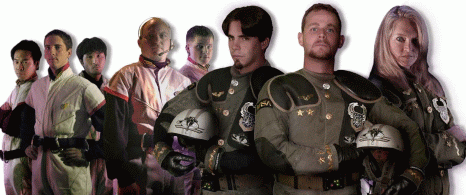
A-T: Besides DARKSTAR, you also have your own studio, called Parallax Studio. I'm curious: Was DARKSTAR more the kind of hobby project you and your team developed besides work or was DARKSTAR a full time job for you all along?
Williams: Hobbies are something you do on weekends. Or perhaps something you do every month or so for short periods of time between your real gigs. I think the term you’re looking for is “labor of love”, and yes indeed, that is what it was. I could have taken the nearly half a million dollars cash and ten years of my life and put it into real estate if I wanted to become rich.
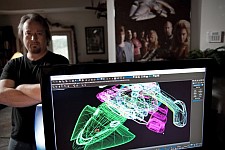 I knew in the beginning it would be a huge project, but I was thinking maybe three years at 20-30 hours a week, and cost maybe fifty grand. And perhaps the original vision I had might have come near that. But it grew and grew, and I deleted the word “no” from my self-vocabulary until about 2009 when I finally said “enough!” Like Pope Julius II screaming at Michelangelo to finish the damned thing, I realized I would add to DARKSTAR until I had died of natural causes if I didn’t set some kind of exit strategy for myself. In the end I worked about 50-70 hours a week toiling 7 days a week for nearly ten years with no pay, no financing, and few breaks. I went through two marriages and watched my children grow up as if in an instant. I hope its not my swan song, but God doesn’t let you do too many decade long projects during our tenure here on earth.
I knew in the beginning it would be a huge project, but I was thinking maybe three years at 20-30 hours a week, and cost maybe fifty grand. And perhaps the original vision I had might have come near that. But it grew and grew, and I deleted the word “no” from my self-vocabulary until about 2009 when I finally said “enough!” Like Pope Julius II screaming at Michelangelo to finish the damned thing, I realized I would add to DARKSTAR until I had died of natural causes if I didn’t set some kind of exit strategy for myself. In the end I worked about 50-70 hours a week toiling 7 days a week for nearly ten years with no pay, no financing, and few breaks. I went through two marriages and watched my children grow up as if in an instant. I hope its not my swan song, but God doesn’t let you do too many decade long projects during our tenure here on earth.A-T: Now that DARKSTAR has finally come to a release, what's the next thing you're going to do? DARKSTAR 2?
Williams: I haven’t decided whether we’ll do a full-blown sequel, but I can tell you right now I won’t do it alone this time. Like I said, I don’t have too many more decade long projects possible, so I’ll probably Direct and Produce the next one. But don’t worry, I am a control freak, so it will be done right or not at all.
In the short term, my new publishing partner and I are working on an International Platinum Version of DARKSTAR that will be subtitled in multi-languages and have lots of added content, it will be a lot of fun to do. I get the idea these guys want to create a “Captain’s Box From Hell”, and I’m all for it.
A-T: Thanks a lot, Jeff and good luck with the release of DARKSTAR!
Williams: Thanks to you Sebastian, you’ve been a great friend to the project for many years, thanks for spreading the word.

Buy Darkstar ($29,95)
Official Darkstar website
Aktuelle Artikel
![]()
Unterstützen
![]()
Adventure-Treff-Verein
IBAN: DE38 8306 5408 0004 7212 25
BIC: GENODEF1SLR
Bitte beachtet, dass wir leider keine steuerrechtlich anrechenbare Spendenquittungen ausstellen können.
Mit jedem Einkauf bei unseren Partnern unterstützt ihr die Arbeit des Adventure-Treff e.V.


